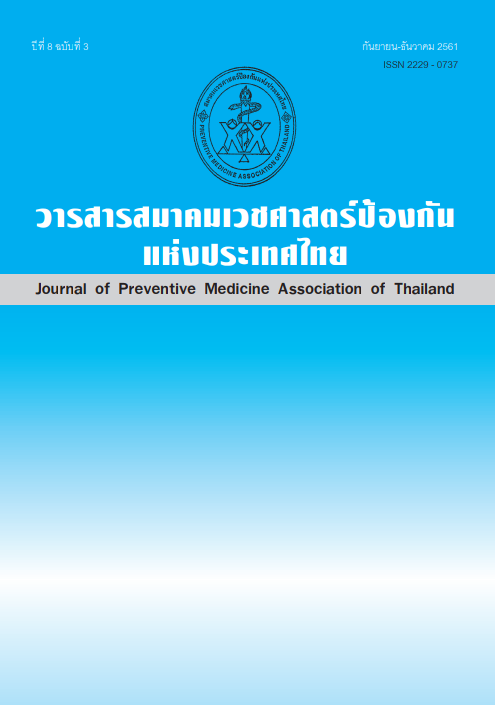Development of Emergency Nursing System in STEMI Patients. Emergency Department, Phra Nakhon Si Ayutthaya Hospital
Keywords:
Emergency nursing system, STEMI patientsAbstract
This was a participatory action research which aimed to analyze situations, problems and obstacles in the Emergency Nursing System, to improve and to evaluate the development of such system for STEMI patients in the Accident and Emergency department (A&E) of Phra Nakhon Si Ayutthaya Hospital. The research was conducted during January-October 2018 and divided into 3 phases. The first phase started by thoroughly examining the situations, problems and obstacles of the system for patients in A&E. Then, series of development in the Emergency Nursing System for STEMI patients took place in the second phase followed by the evaluation of such developed system in the third phase. The samples consisted of 29 professional nurses working in the A&E, the medical records of 107 and 92 STEMI patients before and after the development of Emergency Nursing System, respectively. The research tools were 1) the personal record of professional nurses, 2) the guideline for group discussion, 3) the STEMI patient information form, 4) the STEMI nursing care competency assessment form of professional nurses in A&E, 5) the guideline for STEMI patient care during emergencies, and 6) the data collection form for STEMI patient care practices during emergencies. The qualitative analysis was done by analyzing the contents and deriving conclusions. As for the quantitative data, descriptive statistics, frequency distribution, number, percentage, mean, standard deviation, and Mann Whitney u test were used.
During the first phase of this research, problems were discovered in all areas including the service providers, the users, and the healthcare system. The service providers showed lack of knowledge and confidence in nursing STEMI patient. Moreover, there were not enough necessary medical supplies and equipment. As for the user side, it was found that patients and families were not given enough opportunities to get involved in care planning and lacked of knowledge and understanding about the disease. On the healthcare system, the existing STEMI patient care guidelines were difficult to implement. The second phase were series of professional nursing competency enhancement in nursing STEMI patient, the improvement of hospital STEMI care practices both in general and during the emergency. Lastly, the third phase indicated that, after series of competency enhancement, the performance of professional nurses improved with statistical significance (p<.001). Besides, incidences screening error, incidences of non-compliance with emergency care practices, average duration from STEMI patient admission till receiving ECG taking more than 10 minutes, and incidences of lacking adequate equipment or not available were all significantly reduced (P<.05). However, incidences of STEMI patients not receiving thrombolytics within 30 minutes, incidences of unwanted occurrences while transmitting or relocating patients, and the STEMI patient’s mortality rate at Adverse Event were not significantly different.
References
2. World Health Organization. The top 10 causes of death. [Internet] 2018. [Cited 2018 Jun 21]; Available from: https://www.who.int/news-room/fact-sheets/detail/the-top-10-causesof-death/
3. สำนักนโยบายและยุทธศาสตร์ กระทรวงสาธารณสุข. 5 สาเหตุทำคนไทยเสียชีวิตมากที่สุด. [อินเทอร์เน็ต] 2558. [เข้าถึงเมื่อ 8 กรกฏาคม 2561]; เข้าถึงได้จาก : https://www.hfocus.org/content/2017/03/135902558g/
4. สำนักงานเขตสุขภาพที่ 4. กระทรวงสาธารณสุข. สถิติข้อมูลระบบการบริการสุขภาพสาขาโรคหัวใจ เขตสุขภาพที่ 4 ปีงบประมาณ 2558-2560. นนทบุรี: สำนักงานเขตสุขภาพที่ 4; 2560.
5. คณะกรรมการพัฒนาระบบบริการสุขภาพสาขาโรคหัวใจ โรงพยาบาลพระนครศรีอยุธยา. สถิติข้อมูลระบบการบริการสุขภาพสาขาโรคหัวใจ โรงพยาบาลพระนครศรีอยุธยา. พระนครศรีอยุธยา: โรงพยาบาลพระนครศรีอยุธยา; 2556.
6. จิราวรรณ รุ่งเรืองวารินทร์, ศรีสุรีย์ สูนพยานนท์, อัญชลี คงสมบุญ. การพัฒนาระบบส่งต่อช่องทางด่วนผู้ป่วย STEMI จังหวัดพระนครศรีอยุธยา. วารสารสมาคมเวชศาสตร์ป้องกันแห่งประเทศไทย 2559;6(1):2-14.
7. Donabedian A. An introduction to quality assurance in health care. New York: Oxford University Press; 2003.
8. สำอาง ตันวิเชียร. สมรรถนะพยาบาลวิชาชีพที่ดูแลผู้ป่วยกล้ามเนื้อหัวใจตายเฉียบพลันในโรงพยาบาลติตยภูมิแห่งหนึ่ง จังหวัดสมุทรสาคร. [วิทยานิพนธ์ปริญญาพยาบาลศาสตรมหาบัณฑิต]. นครปฐม: มหาวิทยาลัยคริสเตียน; 2557.
9. Kemmis S., McTaggart R. Participatory action research. In N. Denzin & Y. Lincoln. (Eds.), Handbook of qualitative research 2nd ed. Thousand Oaks, CA: Sage. 2000. p.567-605.
10. จิตรา เลิศสุบิน, กิตติยา เตชะไพโรจน์, นารี แซ่อึ้ง. การพัฒนาระบบบริการพยาบาลผู้ป่วยโรคหัวใจขาดเลือดเฉียบพลัน. วารสารการแพทย์โรงพยาบาลอุดรธานี 2552;17(1):119-127.
11. สุวนิตย์ โพธิ์จันทร์. การพัฒนาระบบการดูแลผู้ป่วยโรคกล้ามเนื้อหัวใจขาดเลือดเฉียบพลันชนิด STEMI ในโรงพยาบาลขอนแก่น. วารสารสมาคมพยาบาลฯ สาขาภาคตะวันออกเฉียงเหนือ 2554;29(1):22-30.
12. วันเพ็ญ แสงเพ็ชรส่อง, ทัชวรรณ ผาสุก, ธนิตา ฉิมวงษ์. การพัฒนาคุณภาพการดูแลผู้ป่วยโรคกล้ามเนื้อหัวใจตายเฉียบพลันระยะวิกฤตในโรงพยาบาลระยอง. วารสารกองการพยาบาล 2555;39(1):32-45.
Downloads
Published
How to Cite
Issue
Section
License
บทความที่ลงพิมพ์ในวารสารเวชศาสตร์ป้องกันแห่งประเทศไทย ถือเป็นผลงานวิชาการ งานวิจัย วิเคราะห์ วิจารณ์ เป็นความเห็นส่วนตัวของผู้นิพนธ์ กองบรรณาธิการไม่จำเป็นต้องเห็นด้วยเสมอไปและผู้นิพนธ์จะต้องรับผิดชอบต่อบทความของตนเอง






